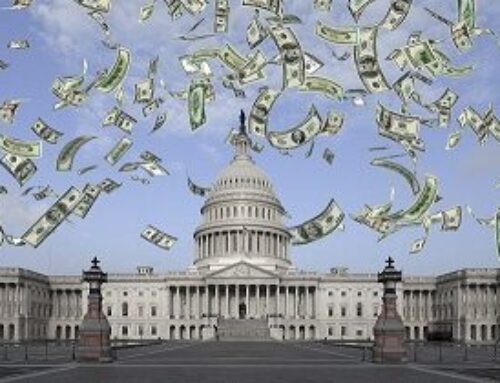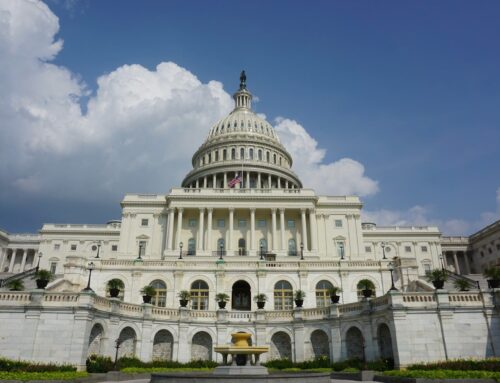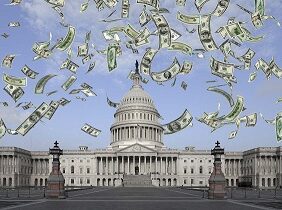A history lesson with special implications for our current debt limit fight about to kick-off in Congress. In times like these, wild things can be agreed to. And in the case of the Budget Control Act of 2011, Congress agreed to all of them… and adhered to none of them. Host Steve Ellis is joined by TCS Senior Analysts Josh Sewell and Wendy Jordan for an episode that respects the admonition that, “those who don’t know their history are doomed to repeat it.”
Listen here or scroll down to read a transcript
Episode 12 — Transcript
[INTRO] Steve Ellis:Today dear listeners, a history lesson with special implications for our current debt limit fight about the kickoff in Congress. So dear Budget Watchdog AF listeners, we set the table on the debt limit issues right here on this show back in early July in a fan favorite episode 10 entitled Extra Money and More Credit.
Well, the limit came and went on July 31st. Currently the Biden treasury department is employing extraordinary measures to keep the nation below the total debt as of that date, July 31st. This is a serious and risky place to be dancing up against the debt limit. Sadly, it is not an unfamiliar place to be for the US government. It’s happened several times in the last decade but this time as Republicans look at the Biden administration spending goals against the current budget situation, they are crying foul on raising the debt limit. Something they decidedly did not do for President Trump.
Joe Mathieu:
Mitch McConnell says no way. The group Taxpayers for Common Sense though reminds us the ceiling has been lifted a hundred times since World War II. Will it happen again?
Steve Ellis:
Sounds like Joe Mathieu over at Bloomberg listened to episode 10. Before we slide headlong into debt limit brinkmanship, let’s pump the brakes and take a quick pit stop for the ABCs of the BCA. The budget control act of 2011.
Then, unlike now, you had a Republican house with a Democrat in the White House, but the Democrats in the house today have just a three vote margin. It’s pretty tight and not far off from the past. As a budget watchdog I have to be honest, the so-called party of fiscal responsibility only seems to care about fiscal responsibility when a Democrat is in the White House. See the routine lifting of the debt limit and excessive spending of the President Trump’s years, but there’s a Dem named Biden at 1600 Pennsylvania Avenue so fiscal restraint is back in vogue. Especially in the light of very, very big spending plans on proffer from the Dems in Congress. I just want to flag that in our quarter century of existence, taxpayers for common sense has always believed in fiscal responsibility no matter who controls Congress or occupies the White House.
Okay, let’s roll back to the BCA. It’s 2011 and the debt limit was approaching like a freight train. In times like these, wild things can be agreed to. In this case they agreed to all of them and adhered to none of them. Today in service of the admonition that those who don’t know their history are doomed to repeat it, Budget Watchdog AF is happy to share the fiscal cliffs notes on the BCA. Joining us to break down the truths, debunk the myths, and see the forest through the trees are TCS senior analysts, Josh Sewell and Wendy Jordan. Josh, those were some crazy years in your early tenure of TCS. Not only after you started was TARP in the midst of the great recession and doing bailout bank bios, then you had the stimulus, then the affordable care act, and then the BCA. Talk to me about it.
Josh Sewell:
Well, forgive me listeners, but the BCA was a budgetary bastard child of a lot of parents. The idea was at its basic level simple. Let’s come up with enough cuts, basically a trillion dollars, that will offset the increase of the debt limit. Now those cuts are stretched over 10 years, but every time the cuts came up short is less debt limit relief. Senator Patty Murray and Representative Jeb Hensarling were tasked with leading this awesome task, but their joint select committee on deficit reduction came up with nothing.
Steve Ellis:
Nothing?
Josh Sewell:
Nothing.
Steve Ellis:
But aren’t super cuts for the super committee.
Josh Sewell:
Well, yeah, Steve, we came up with our compendium of cuts that totaled well over a trillion dollars and offered it up and the so-called super committee, they never agreed to anything. So they cut zero dollars.
Steve Ellis:
Josh, from our supercuts for the super committee, what were some of our suggestions?
Josh Sewell:
I think they were all low-hanging fruit. Ground-based ballistic missile defense. Cut those sitting ducks, $8 billion dollars. Charge royalties on hard rock mining on federal lands. $866 million. Probably not a surprise, stop sending act subsidies to people simply for owning farmland. Cutting that direct payment program, $50 billion in savings.
Steve Ellis:
Wow Josh, I think at that time you weren’t really working on ag policy that much but you still work it into this episode. Well-played my friend.
Josh Sewell:
The seeds were planted way back then.
Steve Ellis:
You reap what you sow as they say. Those all seem like no brainers.
Josh Sewell:
Yeah, but you could describe the super committee that way too. There were some who tried to exploit the committee, like the ag committee, for who the leaders offered a trillion dollar farm bill that supposedly spent $23 billion less than the baseline so it was a deficit reducer. Then there were others who just assumed the super committee would go away and business would get back to usual.
Steve Ellis:
It didn’t really completely work out that way. What was the stick? What was the enforcement mechanism that prevented business as usual at least to some extent?
Josh Sewell:
Well, in case the super committee failed to be super, there was a specter that has haunted Washington since. Sequestrations.
Steve Ellis:
Okay, so I’ve heard of that relic from Gramm-Rudman-Hollings, but-
Wendy Jordan:
Steve, If I may.
Steve Ellis:
Please. That’s my other guest today, Wendy Jordan.
Wendy Jordan:
That’s right. Thanks for having me today. Sequestration is a mechanism that was intended to enforce the budget caps. If Congress couldn’t get its act together and ended up overspending the allocation. Basically if there’s too much money being spent, sequestration as a procedure lops off the tops of all the budget functions. It’s an across the board cut and it lops it off to the earlier agreed upon
Steve Ellis:
But, people hate it, right, because it cuts funding across the board to achieve the savings. The good, the bad, they all get cut.
Wendy Jordan:
Yeah. It’s mindless if you don’t manage it but the point of sequestration was that it was so relentless and across the board that presumably nobody would ever want it to be invoked. That was really the enforcement mechanism. You couldn’t possibly want everything to be cut across the board. Well, we see how that worked out. In fact, Congress didn’t meet the caps.
Steve Ellis:
Right. Josh, this gets me back to the BCA. For all it is vilified, for all of this specter of mindless cuts, it really didn’t do that much, did it?
Josh Sewell:
Right?
Steve Ellis:
Josh, this is a podcast so more than monosyllabic is helpful.
Josh Sewell:
Okay. The BCA set a target for the super committee to reach in total savings. Again, it was roughly one trillion to one and a half trillion dollars over ten years that when coupled with avoided interest costs.
Steve Ellis:
To service or pay for the debt.
Josh Sewell:
Yes, exactly. Would total at least 1.2 trillion in savings. Cut a trillion dollars, count the avoided interest, you get $1.2 trillion in savings. Now, anything less than that would be cuts spread across the 10 years. This is starting at the beginning. If in the beginning of the super committee came up with $600 billion in aggregate spending cuts, the remaining $600 billion would be across the board reductions in both defense and non-defense spread out over the next 10 years.
Wendy Jordan:
Unfortunately they didn’t come up with diddly. In the first year, across the board cuts with some minor adjustments were made. I mean, minor in terms of the federal budget. in anybody’s checkbook it would not be a minor adjustment. Every year after that there was so much complaining and crying about all the mindlessness of sequestration. Which again is the point of using sequestration as your enforcement mechanism. What that ignored was at the top line cut was made, there was so much money to work with on the defense and the non-defense side. If you live within those limits, there are no mindless cuts, right? Stick the budgetary head above the parapet, it gets cut off. Do your job, no across the board cuts. Just DOD had about a half a billion dollars allocated to it over each of those years so plenty of money. It’s not like they were hurting, but they’re having to cry poor because at the Pentagon more is always more.
Steve Ellis:
They got more. I mean, they had that outlet, that relief valve known as OCO, overseas contingencies operations account that totally blew past the caps by having emergency funding. I mean, our podcast listeners know OCO all too well, just like we do.
Wendy Jordan:
Steve, are you suggesting the Pentagon isn’t special? Yeah. They had this OCO account which at its height was over an additional hundred billion dollars for the Pentagon budget which supposedly was off budget. In other words, it didn’t count against the caps for the Pentagon for that year, but certainly added to our deficit. Thankfully for the first time in 15 years, maybe more, there’s no request for the Pentagon in the OCO account in the FY22 budget requests. We’re thankful for that.
Steve Ellis:
Cue taxpayers happy dance.
Wendy Jordan:
You don’t want to see me dancing Steve, just let me assure you.
Josh Sewell:
You had the OCA relief valve for the Pentagon, but you still had to deal with the caps for everyone else and the Pentagon. What we saw were these semi-annual, for the most part, adjustments to the BCA caps. The BBA.
Steve Ellis:
The BBA?
Josh Sewell:
Yeah, so the bipartisan budget acts. Okay, the first adjustment came through the American taxpayer relief act of 2012. Didn’t take them long to have to find an adjustment. It delayed the sequester and reduced spending reductions by $24 billion. After that, it was the BBA of 2013, also known as the Ryan Murray agreement. BBA of 2015. BBA of 2018. You get the point. Each time lawmakers increased spending caps without any real offsets, but get what else these deficit increasers and BCA busters include generally?
Steve Ellis:
Debt limit lifts?
Josh Sewell:
Ding, ding, ding.
Steve Ellis:
Here we are, big spending with the infrastructures package and even bigger spending with the budget reconciliation package and the end of extraordinary measures looming. That’s a lot this month and Congress is hardly working. I’d like to say it’s enough to make a Budget Watchdog sigh, but we will growl. So here we are, people are talking about the halcyon days of the BCA, not recognizing that there were some real issues here and some real challenges and that yes, did the BCA have some impact? It certainly brought up times where we talked about increasing the caps and people talked about the budgets. It had maybe some impact on sort of lowering the baseline for dispense spending. Still having a really increasing trajectory, still adding a lot of billions and billions up to trillions of dollars in spending. In the end, it didn’t achieve its goals by any stretch of the imagination and it was some of this brinkmanship regarding the debt limit that’s really quite scary and we’re facing that right now.
Josh Sewell:
Yeah, and I think it’s important to realize that the treasury is about to exhaust its extraordinary measures. With such slim margins in Congress and this parent new concern about spending, crazy things could happen again. I think it’s really important to realize where we are right now. We’ve seen crazy things happen before. We talked about TARP at the beginning of this, with the great recession and the eventual stimulus in 2008 when Congress was trying to figure out what to do or not to do as far as helping the banks out and what to do in this apparent crisis that was coming down the tracks, they did nothing at first.
Steve Ellis:
They did less than nothing. They actually voted down TARP and then while the markets were open and you just saw that market plummeting that got them to pay attention.
Wendy Jordan:
Honestly, I think we have been at the brink with the debt limit so many times over the last 10, 15 years that we’ve become a little numb to what could actually happen if a solution isn’t found. I’m going to go back to what Josh said a minute ago. The margins are so slim now in Congress. For me it’s a little terrifying because I don’t know what’s going to happen. 10 years ago when there was a debt limit vote coming I knew what was going to happen. There was going to be a lot of talk and then they would vote to raise the debt limit. I am not sanguine that that’s what’s going to happen this time.
Steve Ellis:
What makes it scary, I mean we talked about TARP and obviously the stock market’s been going gangbusters for a while now. The debt limit and the issues around it, the full faith and credit of the United States are much more tricky than the stock market. If we actually just for a day go off that cliff, it’s going to be really hard to put that genie back in the bottle. It’s really hard to convince the markets because what we benefit from the full faith and credit of the United States is that everybody buys our debt.
Steve Ellis:
Our debt is really cheap which is allows us to do these things like a big spending package on infrastructure or the budget reconciliation package in that we can borrow this money relatively cheaply. If we default, even for a day, even for an hour, all of a sudden people may say, the dollar, the bonds, the T-bills, they’re not quite as safe as they were and they’re going to find other ways, they’re not going to totally abandon the US debt, but even if they just stop buying a little bit of it and invest in other ways to hedge their cash, all of a sudden that’s going to have a big impact.
Steve Ellis:
You’re still having issues of where is the dollar going to be the reserve currency of choice. Markets are currently denominated in dollars. Oil is denominated in dollars. It sounds like a lot of a ripple effect from a very small thing, but it really could happen here. Simply saying that you want to get to this to have another BCA when we know that it had some marginal impacts and it had some discussions which we appreciate about debt and the budget, it’s not worth it. We should not be playing chicken with the full faith and credit of the US treasury.
There you have it, the ABCs of the BCA, the budget control act of 2011. Thanks for listening to Budget Watchdog AF. Subscribe and share. Taxpayers for common sense has your back America. We’re reading the bills, monitoring the earmarks, and highlighting those wasteful programs that poorly spent our money and ship long-term risk to taxpayers.










Get Social